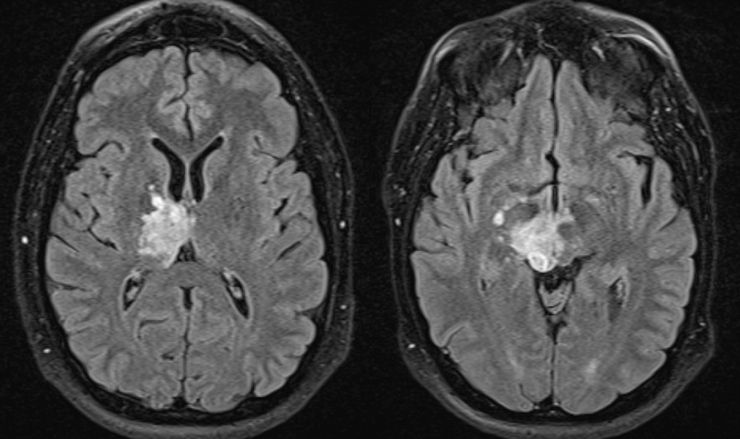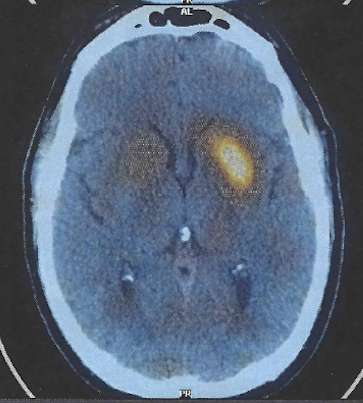Category: Tremor
Objective: To describe a case of cerebellar pathway outflow tremor caused by denervation of the dopaminergic pathway from thalamic and midbrain glioma, which responded to dopaminergic therapy.
Background: A 48-year-old man was seen for left-sided tremor. Initial onset 10 years ago involved intermittent dropping of objects from his left hand. Within 3 years, he developed large amplitude tremor in the left arm and leg with associated motor weakness and sensory changes of the left hemibody. The tremor progressed over the next 4 years to significantly impact his function. Coincidingly he became more lethargic, sleeping up to 16 hours per day, and developed memory issues.
Current examination revealed normal cognition and language with no cortical findings. He had a left esotropia. Motor and sensory examinations were unremarkable. He had no tremor on the right side, however on the left, he had mild rest tremor, large amplitude postural tremor (2-3Hz) worst at wing beating position and significant kinetic tremor of the left arm. He had dysmetria and dysdiadokokinesia of the left hand and left lower extremity coordination difficulties. Gait was normal.
Method: Investigations with MRI and dopamine transporter imaging were performed. A trial of dopaminergic agonist was trialed.
Results: A right paramedian thalamic/midbrain mass was detected, which was consistent with low-grade primary glioma (Figure 1). The tumor has remained stable for 7 years. Dopamine transporter imaging demonstrated severe right sided dopaminergic denervation (Figure 2). The uptake on DaTscan was marked decreased in caudate and putamen, and was more severe than most Parkinson’s patients. The patient showed significant response to low dose Pramipexole, with improvement in tremor and non-motor symptoms.
Conclusion: The phenomenology of the tremor and the involvement of the red nucleus support features of outflow tremor. However, lesions of the thalamus and upper peduncle can cause severe striatal dopaminergic denervation. The denervation may result from damage to the ipsilateral substantial nigra, as well as the nigrostriatal dopaminergic fibers. In this case, the DaTscan and the response to dopaminergic treatment confirm the involvement of the nigrostriatal system. In cases of cerebellar outflow tremor following midbrain peduncular lesion, dopaminergic dysfunction should be considered.
To cite this abstract in AMA style:
K. Yen, A. Yaworski, M. Bussiere, F. Ba. Cerebellar Pathway Outflow Tremor from Thalamic and Midbrain Glioma Responded to Dopaminergic Therapy [abstract]. Mov Disord. 2021; 36 (suppl 1). https://www.mdsabstracts.org/abstract/cerebellar-pathway-outflow-tremor-from-thalamic-and-midbrain-glioma-responded-to-dopaminergic-therapy/. Accessed October 22, 2025.« Back to MDS Virtual Congress 2021
MDS Abstracts - https://www.mdsabstracts.org/abstract/cerebellar-pathway-outflow-tremor-from-thalamic-and-midbrain-glioma-responded-to-dopaminergic-therapy/


